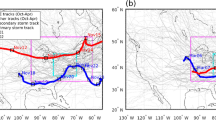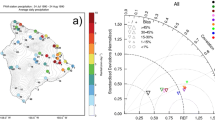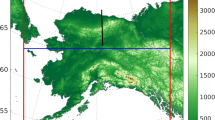Abstract
Topographically channeled winds such as gap winds can be key drivers of freezing rain and ice accretion. Understanding the effect of these winds on the response of freezing rain and ice accretion to global warming is challenging because the spatial resolution of global, and most regional, climate models is too coarse to accurately simulate these winds. To examine the effect of global warming in a region influenced by strong gap winds (the northern Willamette Basin, Oregon, United States), we used 13 year retrospective and pseudo-global warming simulations from a high-resolution, convection-permitting climate model capable of reproducing the easterly gap winds through the Columbia River Gorge. We compared results from the high-resolution model to those from a large ensemble of simulations generated with a coarser-resolution climate model without a well-defined Gorge. Generally, the future projected occurrence of freezing rain decreased at lower elevations and increased at higher elevations. Easterly, low-level winds that bring cold air into the basin were stronger during projected future freezing rain because in a warmer climate, weaker easterly winds were less likely to decrease the basin’s near-surface air temperatures to sub-freezing. Because of the stronger gap winds, more of the projected ice events had longer durations and accreted more ice, even at low elevations downwind of the Gorge. The coarser resolution model also projected stronger easterly winds during freezing rain, which implies that the necessity for stronger easterly winds during future freezing rain is not limited to the gap winds but is a regional, if not more widespread.














Similar content being viewed by others
Data availability
This analysis relied on existing public-available datasets only. NCAR-WRF data were accessed at https://doi.org/10.5065/D6V40SXP. CanRCM4-LE data were accessed at https://crd-data-donnees-rdc.ec.gc.ca/CCCMA/products/CanSISE/output/CCCma/CanRCM4/. ASOS data were accessed at https://mesonet.agron.iastate.edu/ASOS/. PRISM data were accessed at https://prism.oregonstate.edu/.
Change history
15 November 2023
A Correction to this paper has been published: https://doi.org/10.1007/s00382-023-07020-1
References
Allen MR, Ingram WJ (2002) Constraints on future changes in climate and the hydrologic cycle. Nature 419:228–232. https://doi.org/10.1038/nature01092
AP, OPB (2021) Northwest storm leaves hundreds of thousands without power. In: OPB. https://www.opb.org/article/2021/02/14/northwest-storm-leaves-hundreds-of-thousands-without-power
Bernstein BC (2000) Regional and local influences on freezing drizzle, freezing rain, and ice pellet events. Weather Forecast 15:485–508. https://doi.org/10.1175/1520-0434(2000)015%3c0485:RALIOF%3e2.0.CO;2
Bourgouin P (2000) A method to determine precipitation types. Weather Forecast 15:583–592. https://doi.org/10.1175/1520-0434(2000)015%3c0583:AMTDPT%3e2.0.CO;2
Carrière J-M, Lainard C, Le Bot C, Robart F (2000) A climatological study of surface freezing precipitation in Europe. Meteorol Appl 7:229–238. https://doi.org/10.1017/S1350482700001560
Chaîné PM, Skeates P (1974) Wind and ice loading criteria selection. Canadian Climate Centre Internal Report Industrial Meteorology-Study III. Atmospheric Environment Service, Downsview, Ontario
Changnon SA (2003) Characteristics of ice storms in the United States. J Appl Meteorol Climatol 42:630–639. https://doi.org/10.1175/1520-0450(2003)042%3c0630:COISIT%3e2.0.CO;2
Changnon SA, Creech TG (2003) Sources of data on freezing rain and resulting damages. J Appl Meteorol Climatol 42:1514–1518. https://doi.org/10.1175/1520-0450(2003)042%3c1514:SODOFR%3e2.0.CO;2
Changnon SA, Karl TR (2003) Temporal and spatial variations of freezing rain in the contiguous United States: 1948–2000. J Appl Meteorol Climatol 42:1302–1315. https://doi.org/10.1175/1520-0450(2003)042%3c1302:TASVOF%3e2.0.CO;2
Changnon D, Bigley R (2005) Fluctuations in US freezing rain days. Climatic Change 69:229–244. https://doi.org/10.1007/s10584-005-3585-8
Chartrand J, Thériault JM, Marinier S (2023) Freezing rain events that impacted the Province of New Brunswick, Canada, and their evolution in a warmer climate. Atmosphere-Ocean 61:40–56. https://doi.org/10.1080/07055900.2022.2092444
Cheng CS, Auld H, Li G et al (2007) Possible impacts of climate change on freezing rain in south-central Canada using downscaled future climate scenarios. Natural Hazards Earth Syst Sci 7:71–87. https://doi.org/10.5194/nhess-7-71-2007
Cheng CS, Li G, Auld H (2011) Possible impacts of climate change on freezing rain using downscaled future climate scenarios: Updated for Eastern Canada. Atmosphere-Ocean 49:8–21. https://doi.org/10.1080/07055900.2011.555728
Colman R, Soden BJ (2021) Water vapor and lapse rate feedbacks in the climate system. Rev Modern Phys 93:045002. https://doi.org/10.1103/RevModPhys.93.045002
Cortinas JV Jr, Bernstein BC, Robbins CC, Strapp JW (2004) An analysis of freezing rain, freezing drizzle, and ice pellets across the United States and Canada: 1976–90. Weather Forecast 19:377–390
Daly C, Halbleib M, Smith JI et al (2008) Physiographically sensitive mapping of climatological temperature and precipitation across the conterminous United States. Int J Climatol 28:2031–2064. https://doi.org/10.1002/joc.1688
Daly C, Doggett MK, Smith JI et al (2021) Challenges in observation-based mapping of daily precipitation across the conterminous United States. J Atmos Ocean Technol 38:1979–1992. https://doi.org/10.1175/JTECH-D-21-0054.1
Dames J (2022) 2021 Ice storm anniversary: First the snow, then the ice. Why we won’t forget February 2021. In: KOIN. https://www.koin.com/weather/2021icestorm/february-snow-and-ice-the-past-present-and-future
Dunn H (2022) Ice storm knocks power out across OR, WA for second day. In: KOIN. https://www.koin.com/weather/ice-storm-knocks-power-out-across-or-wa-for-second-day
Efron B, Tibshirani RJ (1994) An Introduction to the Bootstrap. CRC Press
Foran A, Haas E (2022) Icy weather continues across the region, causing crashes and closures. In: KOIN. https://www.koin.com/news/oregon/road-closures-crashes-winter-ice-storm-12232022
Groisman PY, Bulygina ON, Yin X et al (2016) Recent changes in the frequency of freezing precipitation in North America and Northern Eurasia. Environ Res Lett 11:045007. https://doi.org/10.1088/1748-9326/11/4/045007
Hausfather Z, Peters GP (2020) Emissions – the ‘business as usual’ story is misleading. Nature 577:618–620. https://doi.org/10.1038/d41586-020-00177-3
Houston TG, Changnon SA (2007) Freezing rain events: a major weather hazard in the conterminous US. Natural Hazards 40:485–494. https://doi.org/10.1007/s11069-006-9006-0
Jeong DI, Sushama L, Vieira MJF, Koenig KA (2018) Projected changes to extreme ice loads for overhead transmission lines across Canada. Sustain Cities Soc 39:639–649. https://doi.org/10.1016/j.scs.2018.03.017
Jeong DI, Cannon AJ, Zhang X (2019) Projected changes to extreme freezing precipitation and design ice loads over North America based on a large ensemble of Canadian regional climate model simulations. Nat Hazards Earth Syst Sci 19:857–872. https://doi.org/10.5194/nhess-19-857-2019
Jones KF (1998) A simple model for freezing rain ice loads. Atmos Res 46:87–97. https://doi.org/10.1016/S0169-8095(97)00053-7
Jones KF (2002) Extreme ice thicknesses and concurrent wind speeds for freezing rain in the Pacific Northwest. U.S Army Cold Regions Research and Engineering Laboratory, Hanover, NH
Jones KF (2023) An analysis of the basis of the Chaîné model for ice accretion in freezing rain. Cold Reg Sci Technol 209:103820. https://doi.org/10.1016/j.coldregions.2023.103820
Jones KF, Thokildson R, Lott N (2002) The development of a US climatology of extreme ice loads. NOAA/NESDIS, Asheville, NC
Klima K, Morgan MG (2015) Ice storm frequencies in a warmer climate. Climatic Change 133:209–222. https://doi.org/10.1007/s10584-015-1460-9
Lambert SJ, Hansen BK (2011) Simulated changes in the freezing rain climatology of North America under global warming using a coupled climate model. Atmos-Ocean 49:289–295. https://doi.org/10.1080/07055900.2011.607492
Le Comte D (2009) U.S. weather highlights 2008: Winter wins. Weatherwise 62:14–21. https://doi.org/10.3200/WEWI.62.2.14-21
Liu C, Ikeda K, Rasmussen R et al (2017) Continental-scale convection-permitting modeling of the current and future climate of North America. Clim Dyn 49:71–95. https://doi.org/10.1007/s00382-016-3327-9
Marinier S, Thériault JM, Ikeda K (2023) Changes in freezing rain occurrence over eastern Canada using convection-permitting climate simulations. Clim Dyn 60:1269–1384. https://doi.org/10.1007/s00382-022-06370-6
McCray CD, Atallah EH, Gyakum JR (2019) Long-duration freezing rain events over North America: regional climatology and thermodynamic evolution. Weather Forecast 34:665–681. https://doi.org/10.1175/WAF-D-18-0154.1
McCray CD, Paquin D, Thériault JM, Bresson É (2022) A multi-algorithm analysis of projected changes to freezing rain over North America in an ensemble of regional climate model simulations. J Geophys Res: Atmos 127:e2022JD036935. https://doi.org/10.1029/2022JD036935
Meinshausen M, Smith SJ, Calvin K et al (2011) The RCP greenhouse gas concentrations and their extensions from 1765 to 2300. Clim Change 109:213. https://doi.org/10.1007/s10584-011-0156-z
Mesinger F, DiMego G, Kalnay E et al (2006) North American Regional Reanalysis. Bull Amer Meteor Soc 87:343–360. https://doi.org/10.1175/BAMS-87-3-343
Millward AA, Kraft CE (2004) Physical influences of landscape on a large-extent ecological disturbance: the northeastern North American ice storm of 1998. Landsc Ecol 19:99–111. https://doi.org/10.1023/B:LAND.0000018369.41798.2f
Nelson M (2004) Portland’s January 2004 Snow/Ice Storm - The failure of mesoscale models. American Meteorological Society, New Orleans, LA
O’Gorman PA (2015) Precipitation extremes under climate change. Current Clim Change Rep 1:49–59. https://doi.org/10.1007/s40641-015-0009-3
OPB (2022) Winter storm blankets Northwest in sleet and freezing rain, leaves thousands without power. In: OPB. https://www.opb.org/article/2022/12/23/oregon-washington-winter-storm-freezing-rain-sleet-power-outages-roads-travel
Rasmussen R, Liu C (2017) High resolution WRF simulations of the current and future climate of North America. Research Data Archive at the National Center for Atmospheric Research, Computational and Information Systems Laboratory. https://doi.org/10.5065/D6V40SXP
Robbins CC, Cortinas JV (2002) Local and synoptic environments associated with freezing rain in the contiguous United States. Weather Forecast 17:47–65. https://doi.org/10.1175/1520-0434(2002)017%3c0047:LASEAW%3e2.0.CO;2
Rupp DE, Li S, Mote PW et al (2017) Seasonal spatial patterns of projected anthropogenic warming in complex terrain: A modeling study of the western US. Clim Dyn 48:2191–2213. https://doi.org/10.1007/s00382-016-3200-x
Rupp DE, Hawkins LR, Li S et al (2022) Spatial patterns of extreme precipitation and their changes under ~ 2 °C global warming: a large-ensemble study of the western USA. Clim Dyn 59:2363–2379. https://doi.org/10.1007/s00382-022-06214-3
Scinocca JF, Kharin VV, Jiao Y et al (2016) Coordinated global and regional climate modeling. J Clim 29:17–35. https://doi.org/10.1175/JCLI-D-15-0161.1
Sharp J, Mass CF (2002) Columbia Gorge gap flow: Insights from observational analysis and ultra-high-resolution simulation. Bull Am Meteorol Soc 83:1757–1762
Sharp J, Mass CF (2004) Columbia Gorge Gap winds: their climatological influence and synoptic evolution. Weather Forecast 19:970–992. https://doi.org/10.1175/826.1
Taylor KE, Stouffer RJ, Meehl GA (2012) An overview of CMIP5 and the experiment design. Bull Am Meteorol Soc 93:485–498. https://doi.org/10.1175/BAMS-D-11-00094.1
Tropea B, Stewart R (2021) Assessing past and future hazardous freezing rain and wet snow events in Manitoba, Canada using a pseudo-global warming approach. Atmos Res 259:105656. https://doi.org/10.1016/j.atmosres.2021.105656
Williams K (2018) 10 years later: The 2008 blizzard that walloped Portland (photos). In: The Oregonian/OregonLive. https://www.oregonlive.com/news/erry-2018/12/0e131ca88d8678/10-years-later-the-2008-blizza.html
Zhou B, Gu L, Ding Y et al (2011) The Great 2008 Chinese Ice Storm: Its socioeconomic–ecological impact and sustainability lessons learned. Bull Am Meteorol Soc 92:47–60. https://doi.org/10.1175/2010BAMS2857.1
Acknowledgments
We thank John Scinocca for making additional variables from the CanRCM4-LE archive available online and Dae Jeong and Kyoko Ikeda for fielding our questions about CanRCM4-LE and NCAR-WRF, respectively. This work was supported by Portland General Electric, Portland, Oregon, USA.
Author information
Authors and Affiliations
Contributions
All authors contributed to the study conception. The study was designed by DER and the analysis was performed by DER. The first draft of the manuscript was written by DER and all authors commented on and revised previous versions of the manuscript. All authors read and approved the final manuscript.
Corresponding author
Ethics declarations
Conflicts of interest
The authors have no relevant financial or non-financial interests to disclose.
Additional information
Publisher's Note
Springer Nature remains neutral with regard to jurisdictional claims in published maps and institutional affiliations.
The original online version of this article was revised: In this article the wrong Supplementary file was replaced.
Supplementary Information
Below is the link to the electronic supplementary material.
Rights and permissions
Springer Nature or its licensor (e.g. a society or other partner) holds exclusive rights to this article under a publishing agreement with the author(s) or other rightsholder(s); author self-archiving of the accepted manuscript version of this article is solely governed by the terms of such publishing agreement and applicable law.
About this article
Cite this article
Rupp, D.E., O’Neill, L.W., Fleishman, E. et al. Response of gap wind-driven freezing rain and ice accretion in the Willamette Basin, Oregon, to global warming. Clim Dyn 62, 807–827 (2024). https://doi.org/10.1007/s00382-023-06991-5
Received:
Accepted:
Published:
Issue Date:
DOI: https://doi.org/10.1007/s00382-023-06991-5




